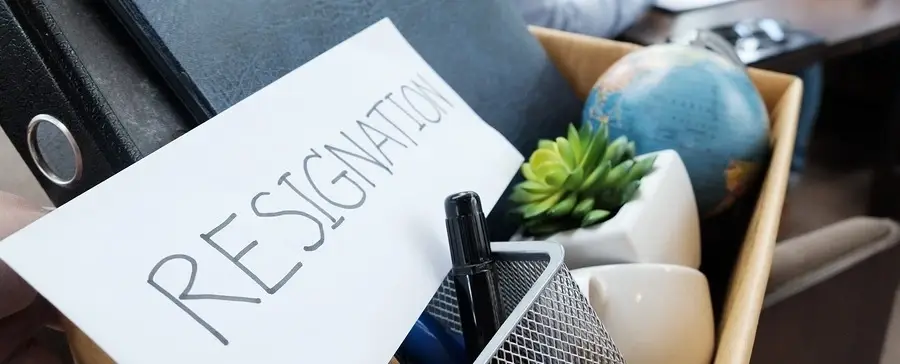Letter of Resignation Template | Template Toolbox

Whether you have one foot out the door or you’re dealing with some major I-can’t-believe-I’m-really-leaving anxiety, when it’s time to resign from your current job, you’ll want to be sure that you leave gracefully. That includes submitting your notice respectfully, with appreciation, and in a timely manner.
Here’s everything you need in order to draft a letter of resignation that covers all of the bases without burning any valuable bridges.
What to include (and what to leave out) in your letter of resignation
- Create a clear subject line. The clearer and more direct you can be from the jump, the better. Start with your subject line, as this will not only help to manage the expectations of your email recipient prior to reading the message, but it will also help to ensure that your email won’t fall through the cracks.
- Include an official, final date. While you may feel compelled to offer a month or more, rest assured that two weeks is standard, and nobody can fault you for leaving too early as long as you give at least two weeks. If at all possible, select a final day that gives you at least a few days—if not an entire week, or even two—in between jobs to help you relax and recharge before you dive into a brand new job and work environment. Before selecting your final day in the office, you’ll also want to check your organization’s benefits and resignation policies to confirm what happens to any remaining PTO days and whether those get paid out upon your departure.
- If you’re interested in helping to fill your position, make that clear. There should not be any expectation that you make yourself available to select a person to fill your position. However, if you do happen to have a colleague in mind who would be an ideal candidate, feel free to include that information in your letter.
- Be specific about what you are willing to commit to. If you’re not clear about what you can complete prior to your departure, you may find that you’re suddenly flooded with extra work and new requests once your letter is submitted. Being clear with your employer will help to manage everyone’s expectations as well as temper any temptation on their part to get as much out of you as possible before your final day. One thing that you should always find time for, however, is the creation of a detailed transition plan. This plan informs your supervisor where important files live, what login credentials are, how to train somebody to take over your role, any unfinished items, and anything else that you think will be helpful as your employer navigates your transition out of the organization.
- Show gratitude. This is an easy one. No matter what your experience, it’s important to find something genuine for which you'd like to show your gratitude. Do you appreciate the opportunity to be a part of such a great team? All of the amazing professional development opportunities you enjoyed? Your supervisor’s knack for challenging and supporting you? Share that in this letter.
- Don’t get into the details of the new gig. Sure, colleagues will ask where you’re headed, and it’s up to you whether or not to share that information. But you should definitely avoid getting into any of these details in your letter of resignation. Stay focused on the task at hand (resigning) rather than offering up a hundred details (or excuses) about why you’re leaving and where you’re headed. If you do have important details to share, save them for the exit interview.
- Don’t make any assumptions about who should be on that initial email. Whatever you do, don’t send an all-staff letter of resignation! And in fact, it's usually best to hold off on informing human resources (if you’re lucky enough to have dedicated HR staff) until you’ve notified your direct supervisor. Unless you have a major issue with your direct supervisor (perhaps this is related to why you’re leaving your job?) and you don’t feel comfortable delivering this news to her without the support of HR, your direct supervisor should be the first to know of your resignation. Once you have shared your letter with her, you can work together to figure out which of your colleagues should learn about this potentially-sensitive information, and when.
Letter of Resignation Template
Email Subject: Submitting my resignation | [YOUR NAME]
Dear [NAME OF SUPERVISOR],
I’m emailing today to submit my two weeks notice and let you know that [DATE] will be my final day as [CURRENT TITLE] with [ORGANIZATION NAME].
Over the course of the next two weeks, I’m highly committed to completing all current projects to the best of my ability. However, I plan to prioritize the following projects as most important to complete prior to my departure:
- Transition plan to support my departure
- [PROJECT NAME AND EXPLANATION OF FINAL DELIVERABLE]
- [PROJECT NAME AND EXPLANATION OF FINAL DELIVERABLE]
I can’t begin to tell you how much I have appreciated all of the opportunities I’ve had here at [ORGANIZATION NAME], and while I’m eager to embark on my next step, I know that the camaraderie and support that I’ve enjoyed as part of your team will not be easily matched.
Finally, while I don’t know whether you have plans to immediately fill the [YOUR JOB TITLE] role, I’d like to recommend [NAME OF COLLEAGUE] as a potential candidate. If you think she may be a fit, I’d be happy to discuss the recommendation further when time permits.
Please let me know if you have any questions for me, and when you may be available to discuss next steps and priorities.
Thank you,
[YOUR NAME]
***
Did you enjoy this post? There's plenty more where this came from! Subscribe here for updates.
As the Associate Director of Marketing and Communications at Idealist and a lifelong nonprofit professional, Alexis offers job seekers, game changers, and do gooders actionable tips, career resources, and social-impact advice.






